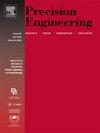Study on photocatalysis/vibration-assisted finishing for deterministic polishing
IF 3.7
2区 工程技术
Q2 ENGINEERING, MANUFACTURING
Precision Engineering-Journal of the International Societies for Precision Engineering and Nanotechnology
Pub Date : 2025-04-19
DOI:10.1016/j.precisioneng.2025.04.025
引用次数: 0
Abstract
Reaction-sintered silicon carbide (RS-SiC) is a promising material for optical systems like space telescopes due to its superior mechanical and thermal properties. However, its multiphase composition, high hardness, and chemical inertness pose significant challenges for conventional polishing techniques in achieving both low form error and surface roughness while maintaining processing efficiency. Photocatalytic/vibration-assisted finishing is a high-efficiency and high-precision polishing process for RS-SiC. After studying the influencing factors and stability of the tool influence function, this study extends the photocatalytic/vibration-assisted finishing to deterministic polishing. The matrix method utilizing the Lucy-Richardson algorithm was employed to obtain dwell time distribution efficiently. The fluctuating concentric circular tool path is developed to avoid periodic residues, interpolation errors, and frequent "swerves". Based on the above innovations, RS-SiC workpieces are deterministically polished to achieve Gaussian hollow topography with a roughness of 0.33 nm in Ra, 0.42 nm in RMS, and a form error of ±30 nm in PV. This study provides a novel approach to the deterministic polishing of RS-SiC.
光催化/振动辅助抛光的确定性抛光研究
反应烧结碳化硅(RS-SiC)由于其优异的机械和热性能,是一种很有前途的光学系统材料,如太空望远镜。然而,它的多相组成、高硬度和化学惰性对传统抛光技术在保持加工效率的同时实现低形状误差和表面粗糙度提出了重大挑战。光催化/振动辅助抛光是一种高效、高精度的RS-SiC抛光工艺。在研究了影响因素和工具影响函数的稳定性之后,本研究将光催化/振动辅助抛光扩展到确定性抛光。利用Lucy-Richardson算法的矩阵法有效地获得了停留时间分布。为了避免周期性残差、插补误差和频繁的“转向”,设计了波动同心圆刀具轨迹。基于上述创新,对RS-SiC工件进行了确定性抛光,获得了Ra粗糙度为0.33 nm、RMS粗糙度为0.42 nm、PV形状误差为±30 nm的高斯空心形貌。本研究为RS-SiC的确定性抛光提供了一种新的方法。
本文章由计算机程序翻译,如有差异,请以英文原文为准。
求助全文
约1分钟内获得全文
求助全文
来源期刊
CiteScore
7.40
自引率
5.60%
发文量
177
审稿时长
46 days
期刊介绍:
Precision Engineering - Journal of the International Societies for Precision Engineering and Nanotechnology is devoted to the multidisciplinary study and practice of high accuracy engineering, metrology, and manufacturing. The journal takes an integrated approach to all subjects related to research, design, manufacture, performance validation, and application of high precision machines, instruments, and components, including fundamental and applied research and development in manufacturing processes, fabrication technology, and advanced measurement science. The scope includes precision-engineered systems and supporting metrology over the full range of length scales, from atom-based nanotechnology and advanced lithographic technology to large-scale systems, including optical and radio telescopes and macrometrology.

 求助内容:
求助内容: 应助结果提醒方式:
应助结果提醒方式:


